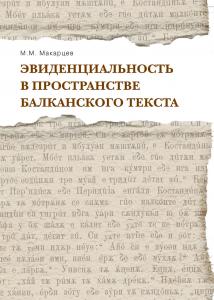Макарцев М. М. Эвиденциальность в пространстве балканского текста
Макарцев М. М. Эвиденциальность в пространстве балканского текста. М.; СПб.: «Нестор-История», 2014. 444 c.
Эвиденциальность — особая лингвистическая категория, с помощью которой говорящий определяет в описании события свою роль — либо непосредственного свидетеля, либо передатчика чужой информации. Язык выработал грамматические, лексические и др. способы выражения эвиденциальности. Исходно нейтральная категория, она, на уровне речи и текста, становится ролевым инструментом (участник или транслятор), инструментом влияния на слушателя. Балканский языковой союз (болгарский, македонский и албанский языки) дает образец «эвиденциального мышления», ярко отпечатавшегося в картине мира. В монографии проведен лингвистический анализ эвиденциальности, который далее перенесен на уровень текста (дискурса). Классический балканский сюжет «Баллада о мертвом брате» и средства массовой информации (болгарская постсоветская пресса; албанские СМИ Косова; македонско-албанский политический дискурс 2010 х гг.) иллюстрируют эвиденциальность в пространстве балканского текста.
Для лингвистов, фольклористов, этнологов, культурологов и всех, интересующихся языками, историей и картиной мира Балкан.
Рец.: П. М. Аркадьев (Москва). М. М. Макарцев. Эвиденциальность в пространстве балканского текста. М.; СПб.: Нестор-История, 2014 // Вопросы языкознания. № 3, 2015. С. 110–116.
Научный редактор — д. ф. н. Т. В. Цивьян
Содержание
ОТ АВТОРА
ВВЕДЕНИЕ
ЧАСТЬ I. ЭВИДЕНЦИАЛЬНОСТЬ В ЯЗЫКОВОМ КОДЕ
1. ПОНЯТИЕ И СТРУКТУРА КАТЕГОРИИ ЭВИДЕНЦИАЛЬНОСТИ
1.1. Эвиденциальность в кругу других грамматических категорий
1.2. Структура категории эвиденциальности
1.3. Виды эвиденциального маркирования
2. ГРАММАТИЧЕСКИЕ МАРКЕРЫ ЭВИДЕНЦИАЛЬНОСТИ В БАЛКАНСКИХ ЯЗЫКАХ
2.1. Инвентарь
2.2. Ареальная дистрибуция
2.3. К происхождению грамматических маркеров эвиденциальности в балканских языках
3. ЛЕКСИЧЕСКИЕ МАРКЕРЫ ЭВИДЕНЦИАЛЬНОСТИ В БАЛКАНСКИХ ЯЗЫКАХ
3.1. Инвентарь
3.2. Дистрибуция
3.3. Проблема «межбалканского» перевода лексических маркеров
ЧАСТЬ II. ЭВИДЕНЦИАЛЬНОСТЬ В ТЕКСТЕ
4. ФОЛЬКЛОРНЫЙ ТЕКСТ СКВОЗЬ ПРИЗМУ ЭВИДЕНЦИАЛЬНОСТИ
4.1. Эвиденциальное маркирование на лексическом уровне: лексико-семантические группы глаголов и формулы
4.2. Эвиденциальное маркирование на уровне текста
4.3. Лингвистический эксперимент
5. ЭВИДЕНЦИАЛЬНОСТЬ В ЯЗЫКЕ СРЕДСТВ МАССОВОЙ ИНФОРМАЦИИ
5.1. Болгарская пресса на рубеже 1980-х–1990-х: «стратегия объективности»
5.2. Косовские албанские электронные СМИ в 1994–2000 гг.: оппозиция свой/чужой
5.3. Эвиденциальность vs. перфект в македонско-албанском политическом дискурсе конца 2000-х.
ЗАКЛЮЧЕНИЕ
МАТЕРИАЛЫ ЛИНГВИСТИЧЕСКОГО ЭКСПЕРИМЕНТА
ПЕРЕВОД АЛБАНСКИХ ВЕРСИЙ «БАЛЛАДЫ О МЕРТВОМ БРАТЕ»
СПИСОК ИСПОЛЬЗОВАННЫХ ВЕРСИЙ «БАЛЛАДЫ О МЕРТВОМ БРАТЕ»
СОКРАЩЕНИЯ
БИБЛИОГРАФИЯ
ИСТОЧНИКИ
ПРЕДМЕТНЫЙ УКАЗАТЕЛЬ
УКАЗАТЕЛЬ ИМЕН
RESUME
The book attempts to provide a new approach to evidentiality, a specific linguistic category, indicating the source of information, using Bulgarian, Macedonian and Albanian data.
In the first chapter (“The concept and structure of evidentiality”) I dwell upon evidentiality together with mirativity and epistemicity within a more general semantic frame of distance.
In the second chapter (“Grammatical evidentials in Balkan languages”) the inventory of grammatical(ised) witnessed and unwitnessed evidentials is provided. Witnessed evidentials in Bulgarian are forms in -х-/-š-/-ø-, in Macedonian they are forms in -v-/-š-/-j-/-ø-, in both languages dating back to Common Slavic aorist and imperfect. Unwitnessed evidentials in Bulgarian and Macedonian are l-forms (dating back to Common Slavic perfect); in Albanian they are inverted perfect forms with apocoped participle ending (cf. ka shkruar ‘He has written.’ vs. shkrua-ka ‘He writes, indeed!’ or ‘He allegedly writes’). The description is provided not only synchronically (both in standard language and in dialects), but also diachronically.
What until recently was the main object of interest in the majority of studies in Balkan evidentiality (its forms and its place within the grammatical system of a given language), in this book is a starting point of moving towards the description of evidential marking in the context. First of all, the cases of common usage of lexical and evidential markers are considered (the third chapter, “Lexical evidential markers in Balkan languages”). The common usage takes the multiple meaning of both types of markers at play, but in each and every case the meanings are not multiplied, but limited, so that we are able to define the straightforward meaning of the construction.
In the second part of the book I dwell upon the role the grammatical evidentials play in structuring the discourse (“narrative prospective”) and texts (its division into meaningful chunks; marking of abstract and complicating action in Labov’s terms).
The fourth chapter (“Folklore text through the looking glass of evidentiality”) is focused on evidential markers in one Balkan text, which exists in many versions – the Dead Brother’s Song. In folklore language the straight evidential meaning (“I saw it.” vs. “I was told.”) becomes irrelevant, and their main function is the indication of the semiotic prospective the singer of tales is taking with the respect of the text being told (inside/outside) and structuring the text itself (its beginning/end/junctures of the meaningful chunks; word formulas; lexical groups of verbs of speech and verbs of motion).
The fifth chapter (“Evidentiality in the language of the media”) includes semiotic analysis of grammatical evidentials usage during the large scale socual and political changes in the Balkan states. I take under consideration Bulgarian reports from the USSR/post-Soviet space in the late 1980s-early 1990s, Kosovo Albanian electronic media during the Kosovo crisis in 1990s and Macedonian and Albanian bilingual political discourse ten years after the radical changes in the language and national policy in Macedonia after Ohrid agreements in 2001. What is important for evidential marking in texts like these is not the witness/non-witness status of the speaker, but the oppositions near/far and one/other (friend/foe).
It is remarkable that the way grammatical evidentials are used in folklore texts and in mass-media discourse has little to do with evidentiality as it is usually defined, but the base of this usage is the semiotic opposition of information as marked as one (= included in the personal memory sphere of the speaker) or other (= the information towards which the speaker holds some distance). And this brings us back to the primary meaning of distance we believe to lie under the evidential opposition.

